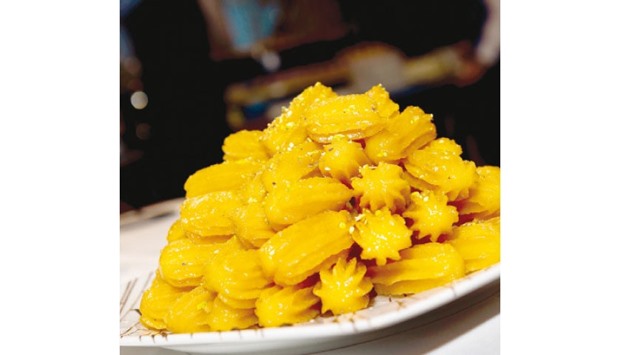With each passing day during this Ramadan, one thing that satisfies me the most is the happiness on the faces of fasting people when they break their fast and finish their meals — especially the desserts at the buffet.
Although Arabic sweets and pastries do not need an introduction, they are popular around the world and are liked by the masses. They range from the easy to make omali to time taking baklava to the delicate kunafeh to cheese delicacies like Halawet el Jibn. One humble dessert that forms a significant part of my dessert buffet is the Balah el Sham.
Balah el Sham simply translates as “Dates of Sham,” a famous city. It is basically a deep fried pastry sweetened with rose flavoured sugar syrup and is made from unleavened dough lump (about 10 cm long) given a small ovoid shape with ridges along it using an ‘icing’ bag with a special nozzle. It is first deep-fried to golden colour and then soaked in rose scented sugar syrup while still hot and is later served cold.
One more story related to Balah el Sham is by its different name of Asabe Zainab, which means Zainab’s fingers. The story goes that 100s of years back, a woman named Zainab created this dish and the sweet is thus named after her. I strongly believe that discovering and talking about the stories behind traditional Ramadan food helps us bond more with the traditions and hand over the culinary heritage to our new generations.
Whenever I relish this delicate dish, it reminds me about the Indian dessert Jalebi, which is made with a similar recipe. But the dough instead is coloured with saffron and piped in a particular shape in the hot oil using a special knitted cloth and then soaked in sugar syrup and served hot.
Balah el Sham is a simple recipe that is not only easy to prepare but is a treat for your taste buds. This dessert finds its way in most Iftar buffet desserts and is liked by not only Arabs but others as well.
Balah el Sham
Ingredients
Unsalted butter 70 gm
Water 250gm
Flour 300 gm
Egg 6 no
Vanilla extracts few drops
Saffron few strands
Oil to fry
For sugar syrup
Sugar 500 gm
Water 500 gm
Lemon ½ no
Rose water few drops
Garnish
Pistachio to garnish
Method
Prepare the sugar syrup beforehand by boiling sugar and water till the sugar dissolves and becomes thick.
Add a piece of lemon to it while boiling to clarify the sugar syrup, and rose water to impart rose fragrance to it and keep aside.
For the Balah el Sham, boil butter in water till it is melted and gradually add flour.
Stir continuously to avoid getting lumps and to get a sticky dough like choux pastry.
Add eggs one by one and vanilla extracts to the prepared mixture to get a smooth and soft dough.
Pour this mixture into a piping bag with star or fringed round nozzle.
Heat the oil for frying in a heavy bottom pan and tie a steel wire above it to cut the dough.
Pipe the dough on top of the oil carefully not to splash the oil and pass the piping bag nozzle over the steel wire to cut the dough.
You can adjust the length of Balah el Sham by keeping them long or short as per your preference.
The approximate length of the fingers should be 2-3 inches long.
Turn the fingers to evenly fry them to a golden brown colour.
Remove from oil and soak in the prepared sugar syrup to sweeten it.
Drain excess sugar syrup and garnish with pistachio and serve.
Note: To make softer Balah el Sham, reduce the quantity of flour in the recipe a bit. But try the above recipe if making it for the first time so that you have some practice and the product does not break apart while frying or soaking in sugar syrup.
Chocolate Balah el Sham
There has been a recent trend about pairing the classical food with modern or other ingredients that blend well together and complement each other’s taste. So I tried pairing Balah el Sham with dark chocolate and it turned out to be delicious. So after you have prepared your Balah el Sham according to the above mentioned recipe, you can refrigerate them for an hour and then dip them in melted dark chocolate and serve a new variant to your friends or guests.

FINGERS OF SUGARY DELIGHT: Balah el Sham. Photo by Nitin Gaur


